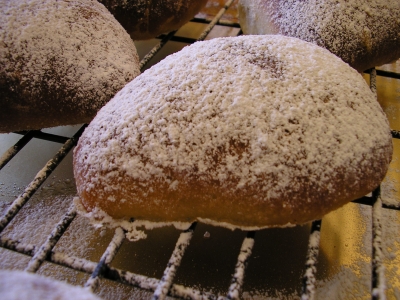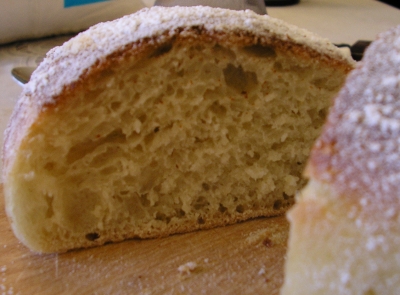
A nice improvement in Bread Baker's Apprentice is that the recipes tend to call for a full batch of the poolish (or biga) recipe in the front. At least, it's a nice improvement if you only bake every once in a while, and prefer to make up a fresh batch of poolish for each baking you do. Since I am trying to get into baking more often, having a bowl of poolish around all the time might actually be a help. At the moment, I've got some in the freezer leftover from this sweet fougasse recipe.
It ended up taking three days to make, but I was able to make it around my work schedule, though I ended up letting it rise in the refrigerator for eight hours when the recipe called for it to ride at room temperature for three. I just tried to guage its readiness by size and it worked out all right.
The "puffy wedges" shape is interesting, but I haven't been able to find if there's a reason they're not made in the cut-out leaf shape of a savoury fougasse. I did find, though, that it's common to flavour the sweet fougasse with anise seed or orange peel, which would definitely be worth trying next time. Even as is, it was very good (and every bit as satisfying as brioche or a croissant, though not very like either)

Sweet Fougasse Recipe
From Crust & Crumb by Peter Reinhart
Poolish:
4 cups bread flour
4 cups cool water
1/4 teaspoon instant yeast
Combine all ingredients in a bowl and mix until smooth.
Cover with plastic wrap and let sit at room temperature 3~5 hours, until bubbly.
The "puffy wedges" shape is interesting, but I haven't been able to find if there's a reason they're not made in the cut-out leaf shape of a savoury fougasse. I did find, though, that it's common to flavour the sweet fougasse with anise seed or orange peel, which would definitely be worth trying next time. Even as is, it was very good (and every bit as satisfying as brioche or a croissant, though not very like either)

Sweet Fougasse Recipe
From Crust & Crumb by Peter Reinhart
Poolish:
4 cups bread flour
4 cups cool water
1/4 teaspoon instant yeast
Combine all ingredients in a bowl and mix until smooth.
Cover with plastic wrap and let sit at room temperature 3~5 hours, until bubbly.
Refrigerate overnight, covered.
Sweet Rustic Bread:
2 cups poolish from above
4 1/2 cups bread flour
5 tablespoons granulated sugar
2 teaspoons salt
1/2 teaspoon instant yeast
2 tablespoons olive oil
1 cup cool water
Confectioner's sugar for dusting
Vegetable oil cooking spray
1. Measure out poolish and let sit at room temperature to take off the chill.
2. Combine the ingredients in a bowl.
3. Mix until gluten develops. (The recipe suggests 8 minutes with a dough hook on medium, or two minutes in a food processor, or 15 minutes by hand, which is what I did.) Cover with plastic wrap and let rise at room temperature three hours, or until increases 1 1/2 times in size. (This is where I left it in the fridge instead for eight hours.)
4. The dough will have stiffened somewhat. (It's possible mine had moreso, due to being in the refrigerator.) Scrape it onto a heavily floured counter, flour your hands, and roll the dough around to coat it, kneading gently a few seconds. Form a loose ball and dust with flour. Cover with plastic wrap and let rise at room temperature one hour.
5. Cover three pans with baking parchment (either flat ones, or invert pans with a lip, because you'll want to be able to slide the dough onto a baking stone in the oven) mist the parchment with cooking spray and sprinkle with semolina flour.
6. Flour your hands and the dough, kneading a few seconds. Pat the dough into a disk about 6 inches in diameter, then cut into 6~8 wedges. (Now, this seems odd. I halved the recipe and still made a disk about 6 inches in diameter, and it seemed awfully thick (like ~2 inches), so I imagine it would be very thick with a full recipe. I cut mine into 6 wedges.) Dip the knife/pastry blade into cold water between cuts so it doesn't stick.
7. Keeping your hands floured, transfer the cut wedges to the pans, leaving lots of room between them. Don't stretch the wedges. Mist with cooking oil, dust with flour, and let proof at room temperature 2 hours, until wedges have increased in size 1 1/2 times. Refridgerate overnight.
8. Remove the pans from the refrigerator 2 hours before baking and let rise until nearly twice their original size.
9. 40 minutes before baking, preheat oven to 475*F, with a steam pan on the lower rack, and baking stone on the upper.
10. Do not score the wedges. Slide them (and the baking parchment) directly onto the baking stone. Spray wedges and oven walls with water and pour 2 cups hot water into steam pan. Close the oven door, then spray the oven with water again after two minutes. After five minutes, reduce oven temperature to 425*F.
11. Bake the for about 20 minutes, rotating once halfway through for even baking.
12. Once wedges are golden brown, remove from oven and move to a cooling rack.
13. Spray the wedges with cooking oil and dust with confectioner's sugar. Let cool for 40 minutes before eating.